JASDF Hamamatsu
I’ll open this report with the statement, that from 1988 through to 1992 I was a resident of Kobe Japan. I grew up watching the Shin Meiwa PS-1 and US-1A flying boat take off from Kobe harbour. It was a great sight and sound and one which I’ll never forget. So the passion for the JASDF is a long and deep seated one. And after many years I was so happy to be back where I spent a portion of my youth watching the Japanese Aviators. Though I had never been to Hamamatsu it certainly felt like at times like going back to those early childhood memories.
Location:
The base is located 5.6 km North of the city of Hamamatsu, Shizuoka Prefecture, in central Japan.
History:
Hamamatsu Air Base was established in 1925 as an Imperial Japanese Army Air Force base to be home to the newly formed IJAAF No.7 Air Regiment. In 1933, it was designated as the primary flight school for Japanese army aviation. After the end of fighting in World War Two , the base facilities were used as an emergency landing strip by the United States Air Force, and were returned to the Japanese government in 1952 for use as a flight training school for the Japan Air Self-Defense Force.
The training syllabus was transformed in 1954 into separate schools for flight training, aircraft maintenance and communications. The base was divided into northern and southern areas in 1958, with the operational area in the north housing the 1st Air Wing, and from 1960, the Blue Impulse aerobatic squadron and the southern area housing the administrative and training facilities.

At the entrance to the base is a Sabre 92-7929 in Blue Impulse livery.
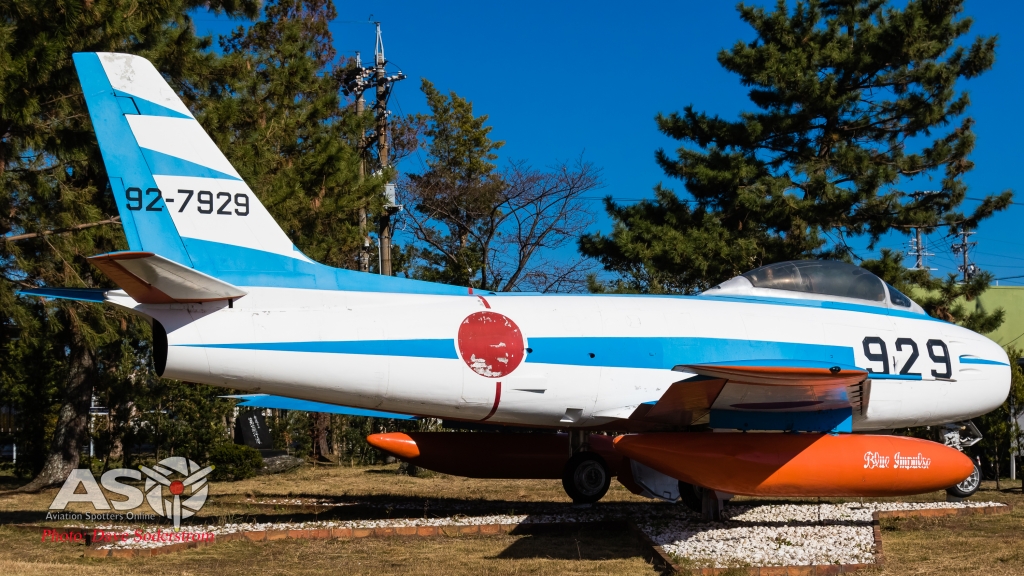
The Sabre was the founding mount of the Blue Impulse team. The team transitioned to the locally built Mitsubishi T-2 in 1980 and to the current mount the T-4 in 1995.
The Blue Impulse squadron was transferred to Matsushima Air Base in 1981, however this was marred when the team suffered a fatal mid-air collision during a farewell performance at Hamamatsu in 1982.
The First Air Wing transitioned from Lockheed T-33A trainers to Kawasaki T-4 trainers in 1988. In 1989, the northern and southern halves of the base were reunited into a single administrative entity. From 1998, Hamamatsu Air Base became the home base of Japan’s squadron of Boeing E-767 AWACS aircraft.
In 1999, an aviation museum, the JASDF Hamamatsu Air Base Publication Centre (航空自衛隊浜松広報館 Hamamatsu Kōhōkan), was established. We have a separate report on this coming up soon!
Aircraft and Squadrons:
The squadrons and units based at Hamamatsu include the following:
- 1st Air Wing
- 31st Training Squadron flying the Kawasaki T-4
- 32nd Training Squadron flying the Kawasaki T-4
- Airborne Early Warning Group
- 602nd Squadron flying the Boeing E-767
- Air Basic Training Wing
- Air Rescue Wing Hamamatsu Detachment flying the U-125A and UH-60J
- Hamamatsu Anti-Aircraft Missile Group
- Air Officer Training School
- 1st & 2nd Technical School
- Air Training Aids Group
- Air Traffic Control Group
- Air Weather Service Group
- Hamamatsu Air Police Group
This report will take in two days of flying including the practice day display by the Blue Impulse display team.
Kawasaki T-4
As noted in the first report about JASDF Iruma, The Kawasaki T-4 is the JASDF’s primary jet trainer. A number are on strength at various squadrons as ‘hacks’. Some 208 aircraft were eventually delivered for service. Both the 31st and 32nd Training Squadrons are based at Hamamatsu flying the type. A 31 Squadron aircraft is identified by a blue stripe under the yellow and black chequer board and 32 with the red line.

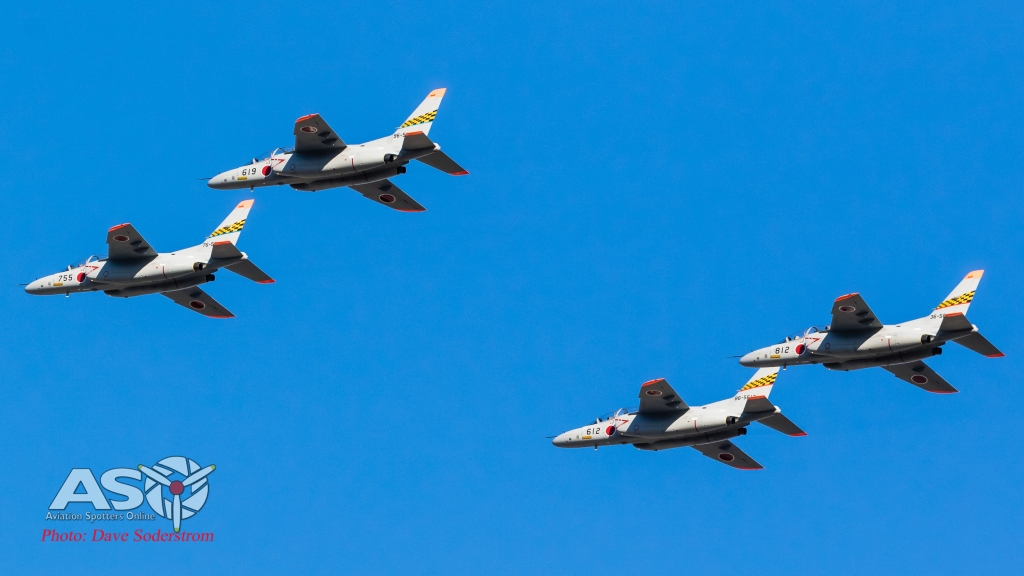
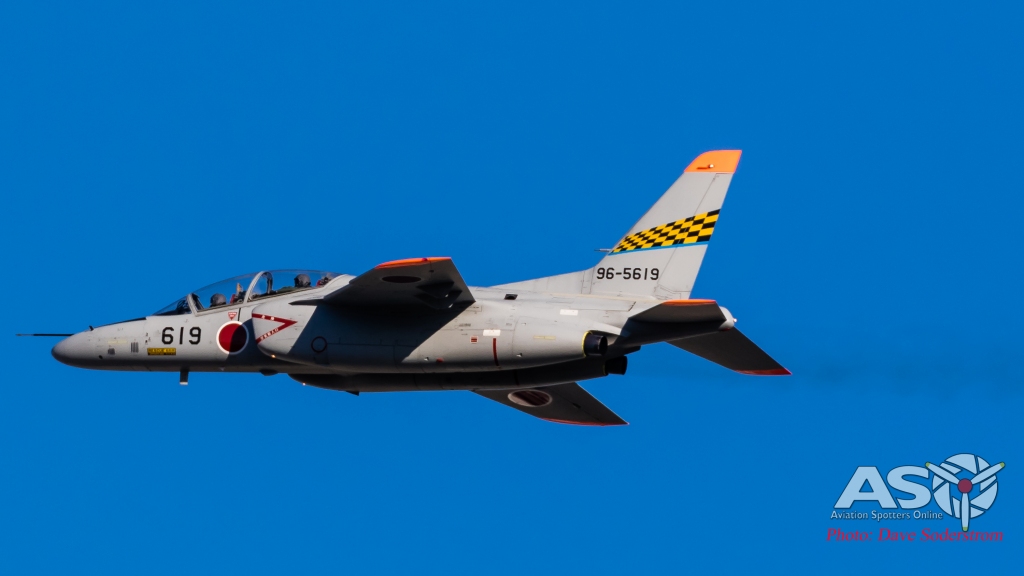
31 Squadron T-4 96-5619 makes a high speed pass down the runway.

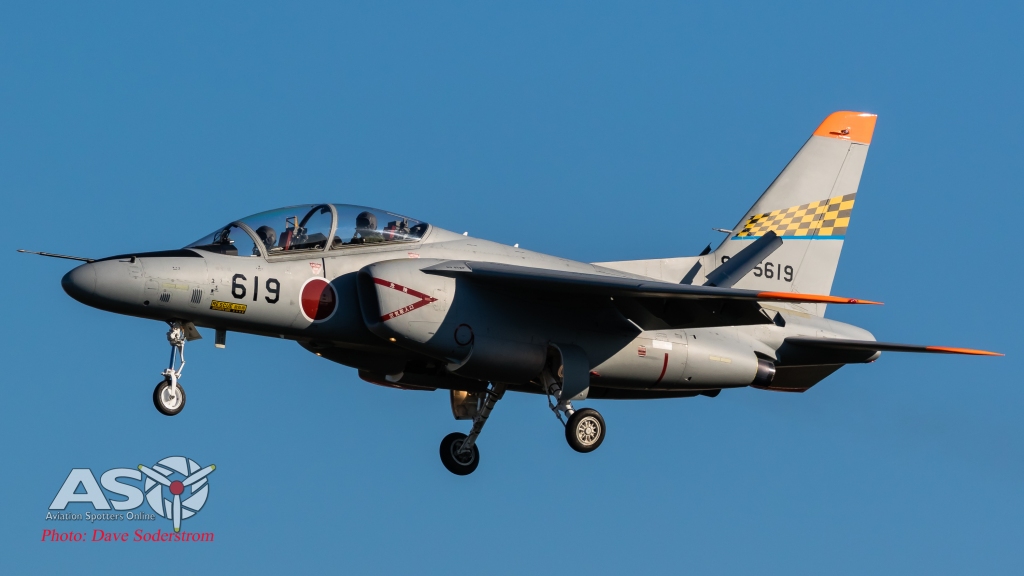

32 Squadron T-4 lands after the formation display.
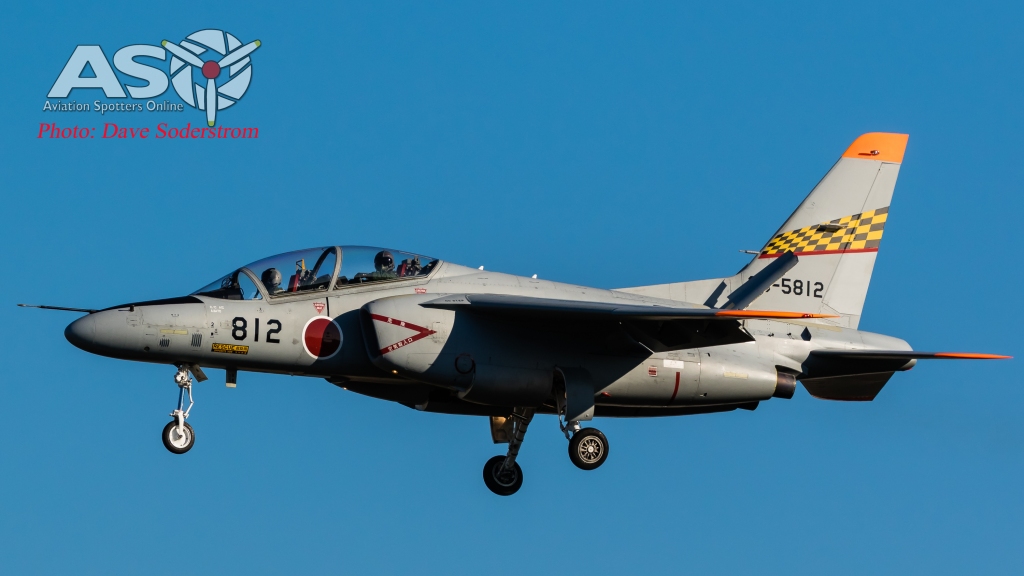
Beechcraft T-400 Jayhawk
Once the T-4s were on the ground it was time to watch a handling display from type I hadn’t seen since an airshow in the United States. The Beechcraft T-400 Jayhawk. Operated by the 41st Flight Training Squadron, the dai41kyouikuhikoutai is a training squadron of the 3rd Tactical Airlift Group. Equipped with 13 of the T-400 Jayhawk aircraft. The squadron trains JASDF pilots who will go on to fly large jet aircraft like the Kawasaki C-1, Kawasaki C-2, KC-767 and E-767.

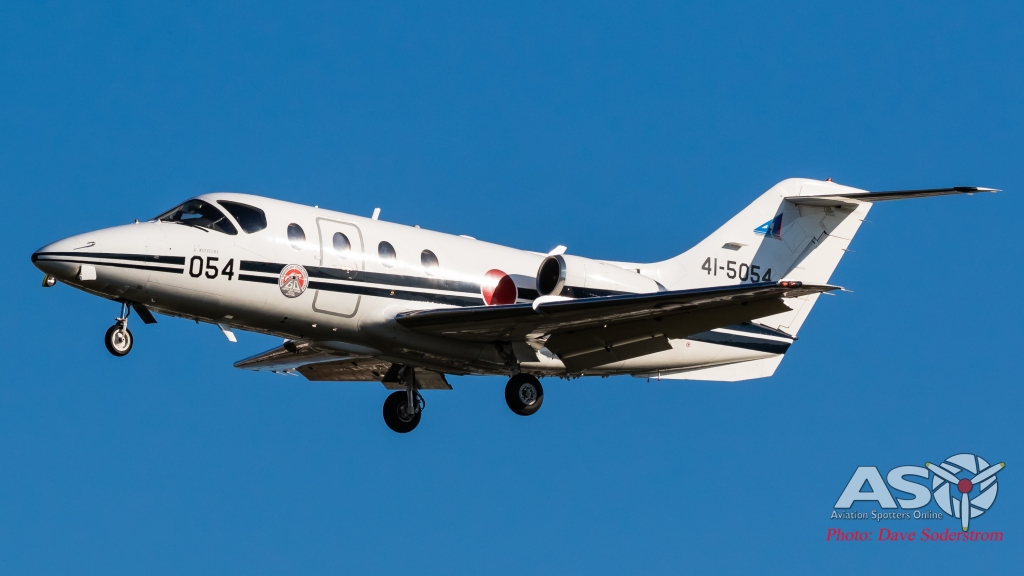
Based at Miho, Tottori the squadron will relocate to Hamamatsu in the near future.
Raytheon (Hawker) U-125A
Another type converted from a biz jet platform for military service is the Raytheon (Hawker) U-125A. The U-125 search-and-rescue variant of the Hawker 800, was engineered and equipped for the maritime search-and-rescue duties that the JASDF require. Features such as large observation windows on either side of the fuselage, a Toshiba 360-degree radar system, Melco thermal imaging equipment (TIE) system, a flare and marker-buoy dispenser, life raft and an emergency equipment dropping system. Other features include a comprehensive suite of communications equipment and enhanced protection against the salt water environment in which the aircraft operate.
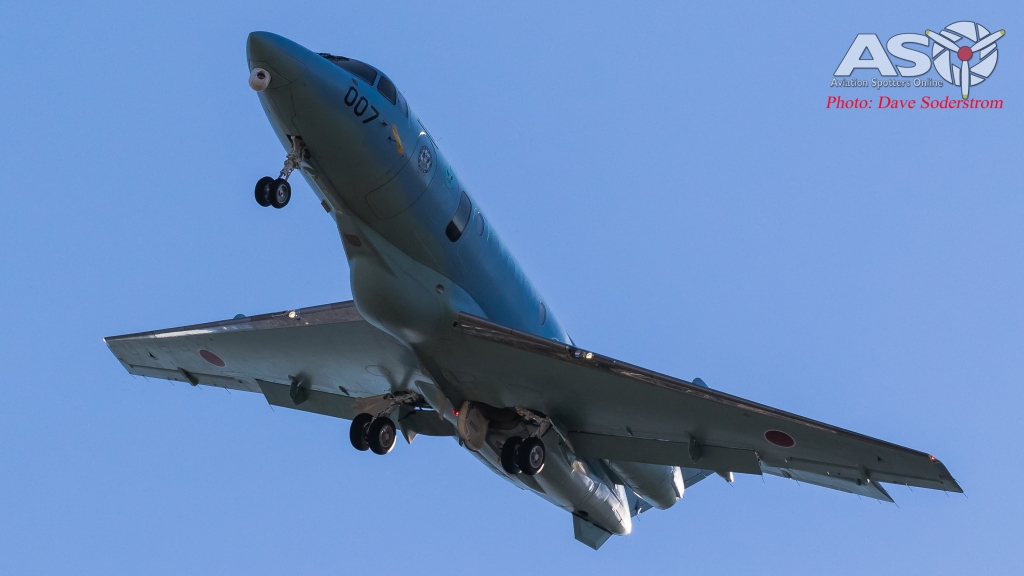
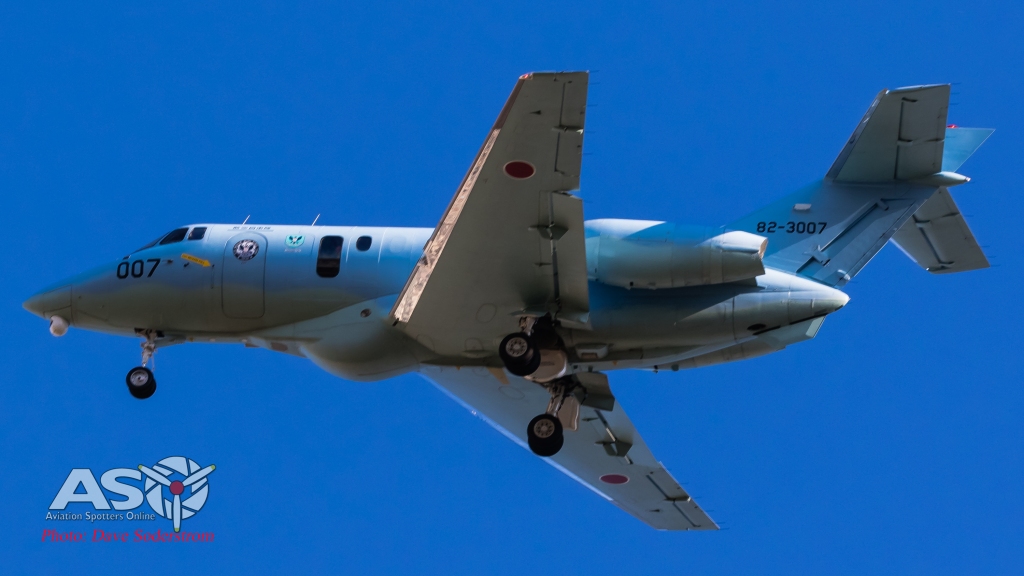


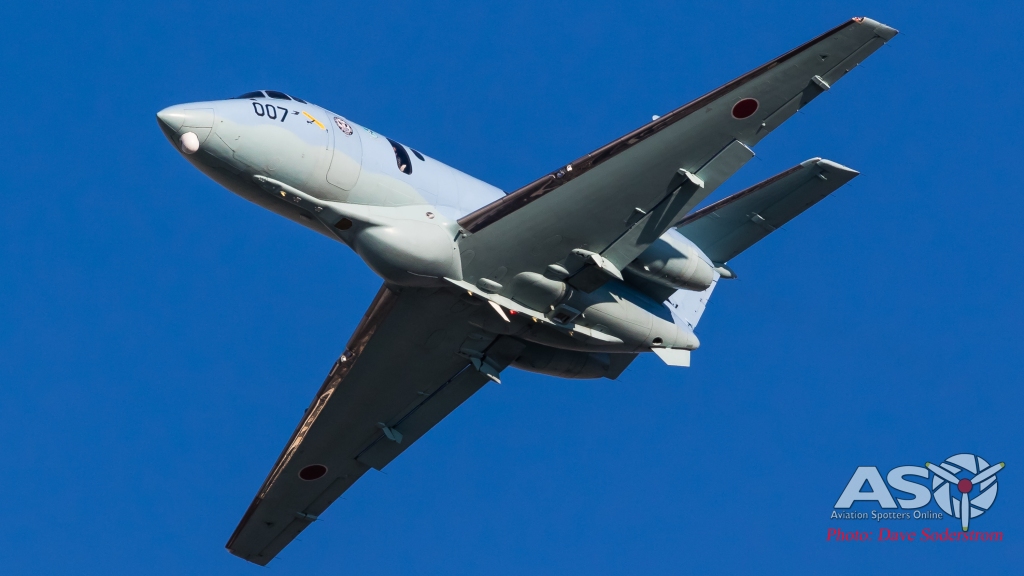
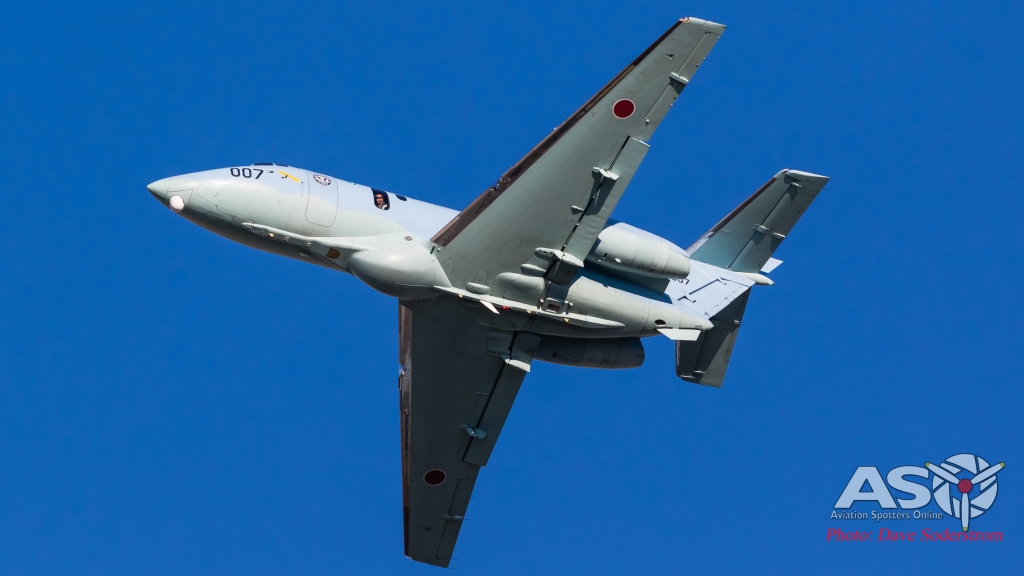
The usefulness of the large observation window is seen here with a crew member getting a great view from it.
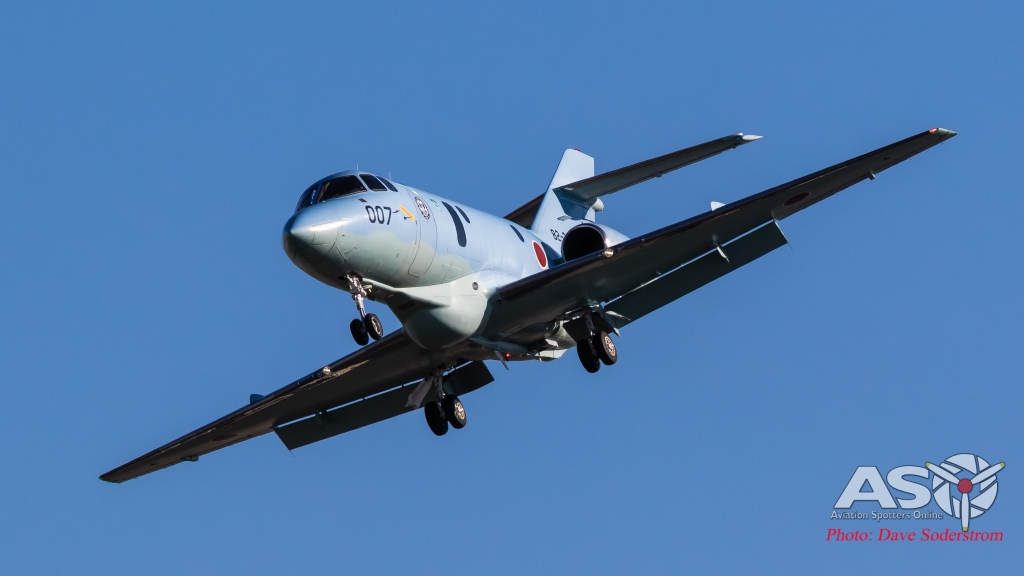
Powered by TFE731-5BR engines, the Hawker is one good looking and preforming jet.

Fourteen Hawkers were ordered initially for the search and rescue role. Operated by the Air Rescue Wing, which headquarters in Iruma, all units operate and fly both the U-125A and UH-60J.
Aircraft are based at the following;
| Air Rescue Wing (HQ: Iruma) Detachments (All are equipped with the U-125A and UH-60J) | ||
| Chitose, Hokkaido | Matsushima, Miyagi | Ashiya, Fukuoka |
| Akita, Akita | Hyakuri, Ibaraki | Nyutabaru, Miyazaki |
| Niigata, Niigata | Hamamatsu, Shizuoka | Naha, Okinawa |
| Komatsu, Ishikawa | Komaki, Aichi (Training Sqn) | |
Sikorsky UH-60J Blackhawk
As mentioned above all base units have UH-60J Blackhawks. A licence built version of the Sikorsky type, Japanese examples where built by local subsidiary Mitsubishi Heavy industries. To date some 178 have been built.
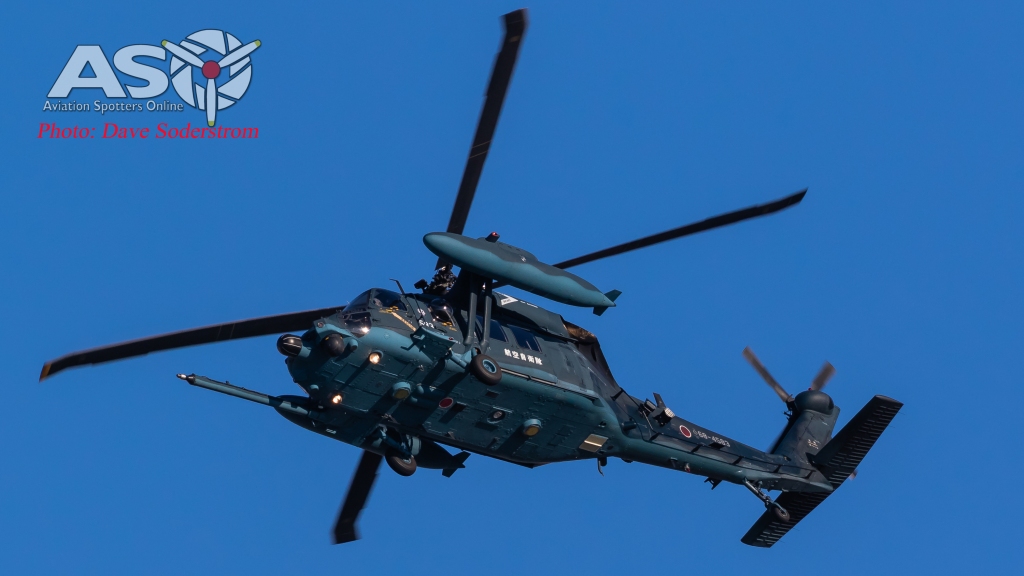

The UH-60J is powered by T700 engines license-built by Ishikawajima-Harima Heavy Industries in Japan. It features external fuel tanks, an external rescue winch, a Japan-built radar, a FLIR turret in the nose and bubble side windows for observer.
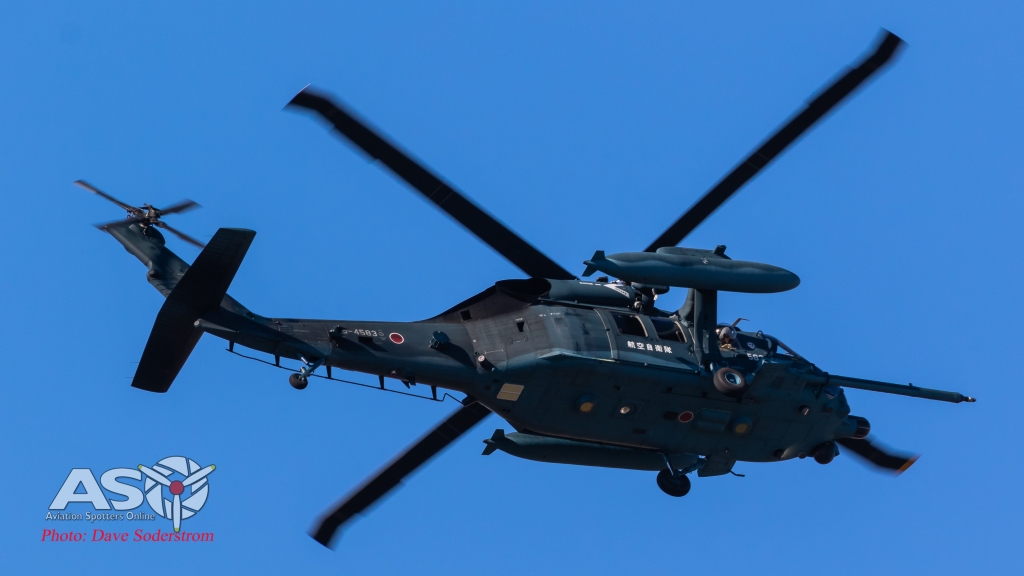
Boeing E-767
A unique aircraft within the JASDF Fleet, the Boeing E-767 was designed in response to the Japan Air Self-Defence Force’s requirements. Taking the Boeing E-3 Sentry’s surveillance radar and air control system and then installed on a Boeing 767-200 airframe. The JASDF took delivery of the first aircraft on March 11, 1998 along with the second E-767. The third and fourth aircraft were delivered in January 1999. Operated as part of the Airborne Early Warning Group (AEWG), and flown by 602nd Squadron which is based at Hamamatsu Air Base.

E-767 is powered by two General Electric CF6-80C2B6FA high bypass turbofan engines, generating 61,500 pounds thrust each. The original 90 kVA electrical generators (one in each engine) were replaced with 150 kVA generators to provide power to the radar and other equipment.

An over fly of an over fly.

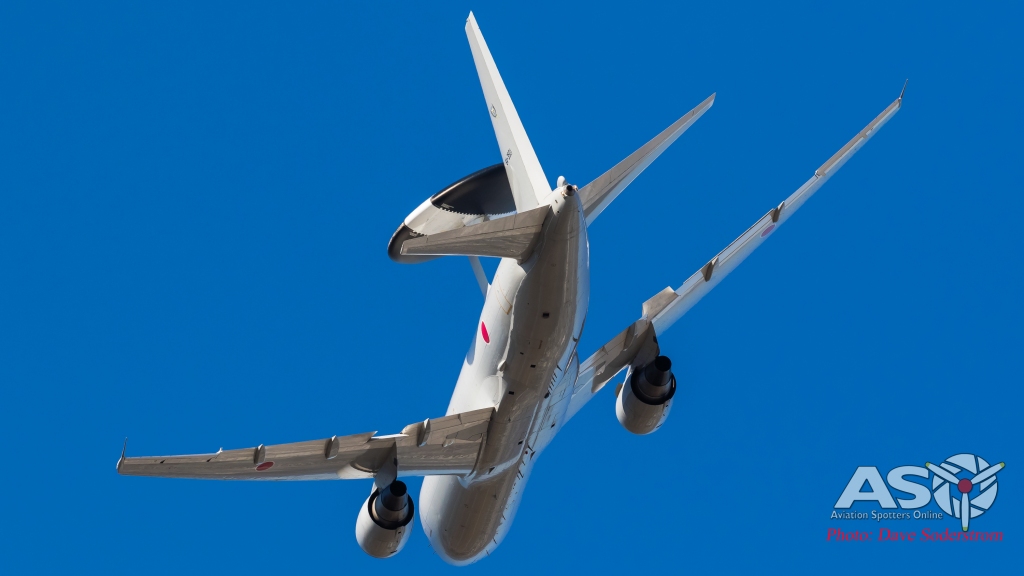
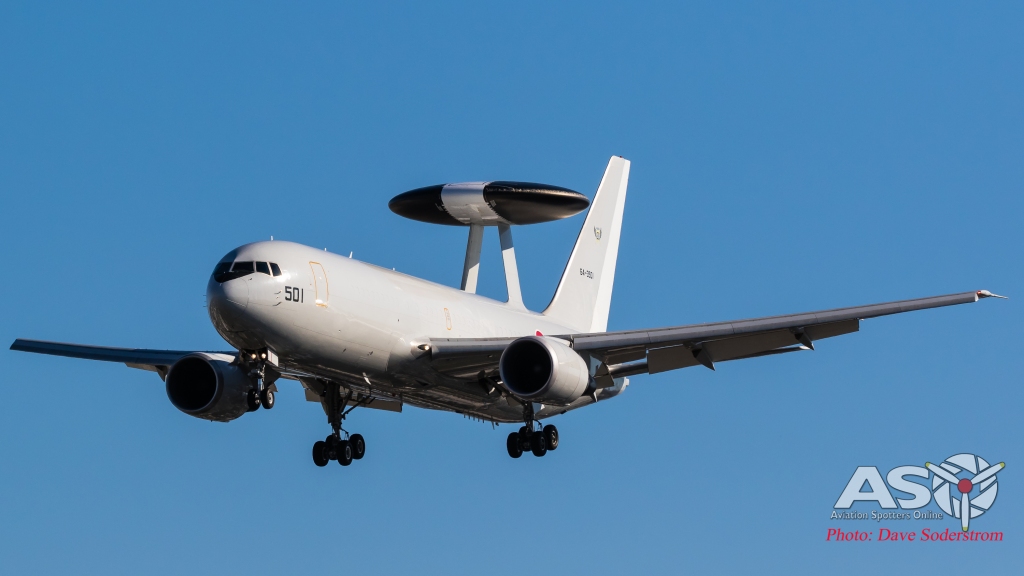

Aircraft 501 or 64-3501 was the first E-767 delivered to the JASDF.
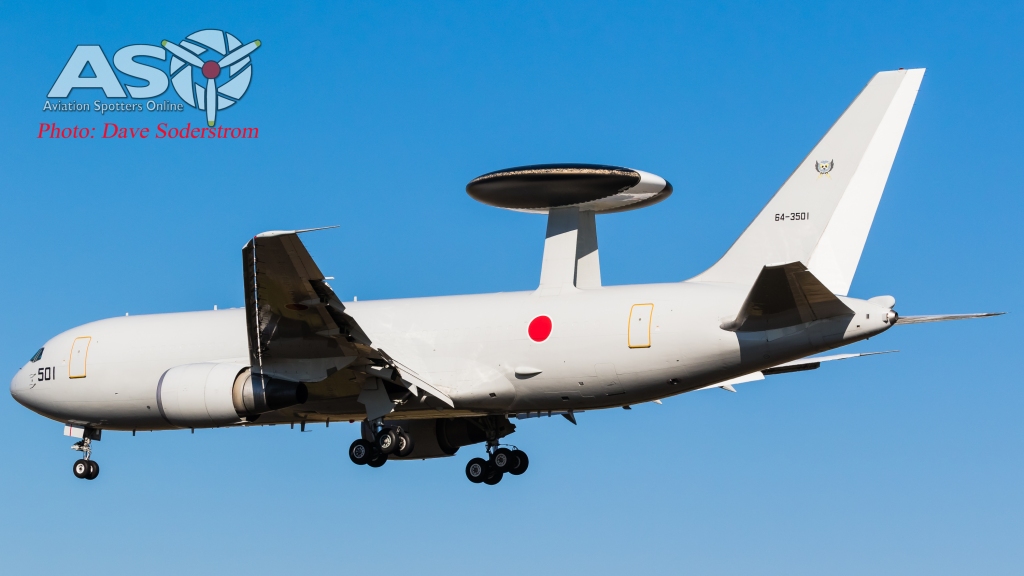


McDonnell-Douglas (Boeing) F-15J/DJ Eagle
The JASDF took delivery of its first US assembled F-15J on the July 15 1980. The first assembled aircraft made at the Mitsubishi Industries plant at Komaki was handed over on the 19th August 1981. To date some 223 aircraft of the F-15J and F-15D/J Eagles have been delivered for service. The JASDF ordered the fourth generation interceptor to replace the large numbers of Lockheed F-104J Starfighters and McDonnell-Douglas F-4EJs in service. The last of which rolled of the production line in 1997. The aircraft has equipped many squadrons over time this includes:
- 2nd Air Wing Chitose Air Base
- 201st Tactical Fighter Squadron (1986-)
- 203rd Tactical Fighter Squadron (1983-)
- 6th Air Wing Komatsu Air Base
- 303rd Tactical Fighter Squadron (1987-)
- 306th Tactical Fighter Squadron (1997-)
- 5th Air Wing Nyutabaru Air Base
- 202nd Tactical Fighter Squadron (1981-2000)
- 305th Tactical Fighter Squadron (1993-)
- 9th Air Wing Naha Air Base
- 204th Tactical Fighter Squadron (1984-)
- 304th Tactical Fighter Squadron (1990-)
- Air Development and Test Wing
- 23rd Flying Training Squadron (2000-)
During the airshow a single example, 55-8853 a F-15DJ operated by the 23rd Flying Training Squadron which is part of the Air Development and Test Wing did the performance.
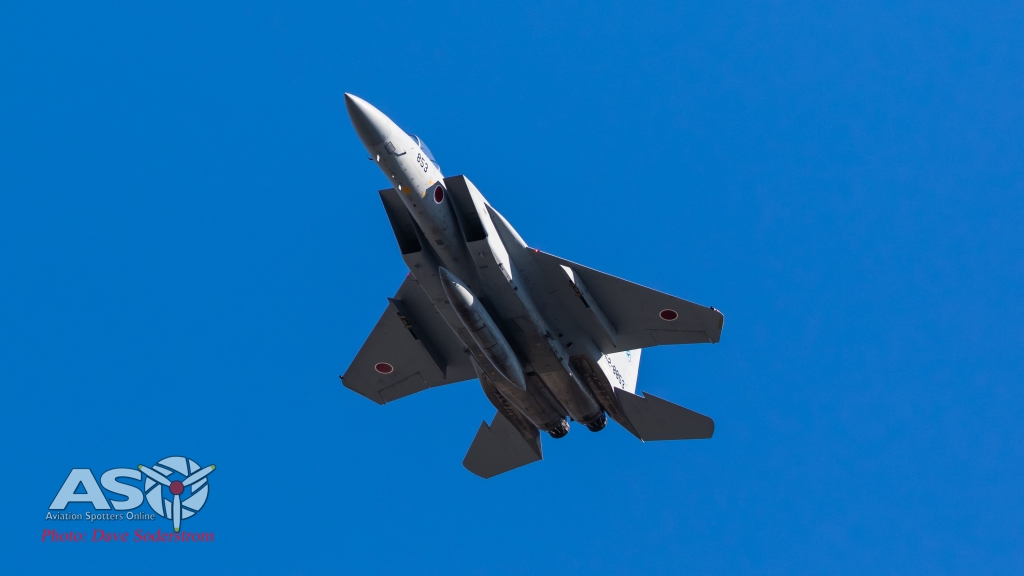

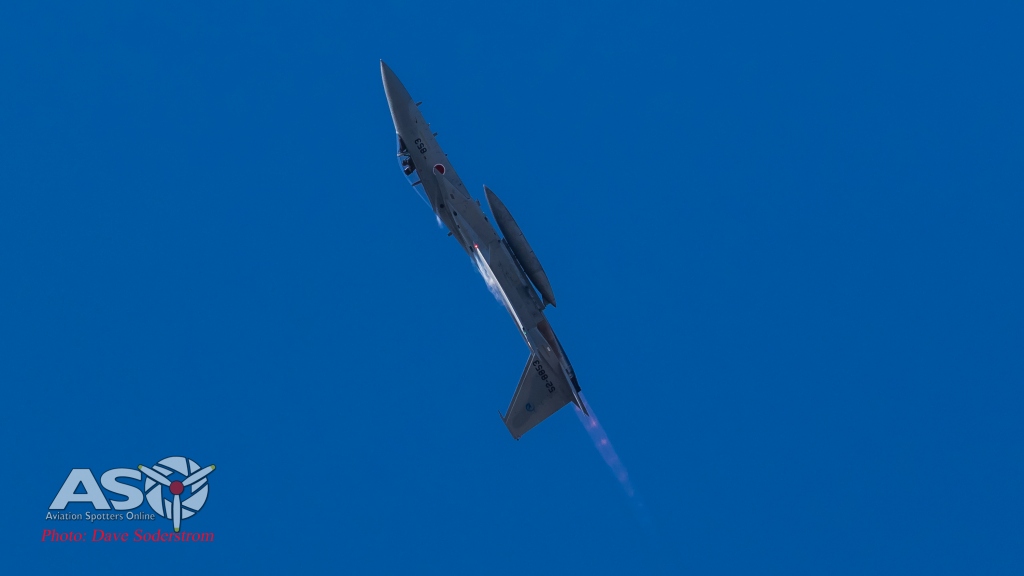
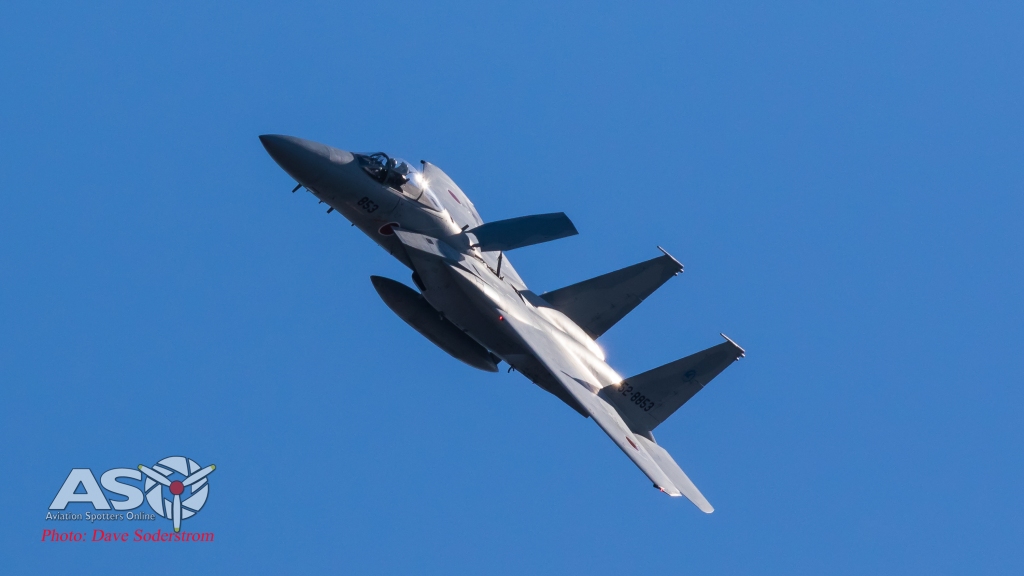
The large speed break is seen here deployed.

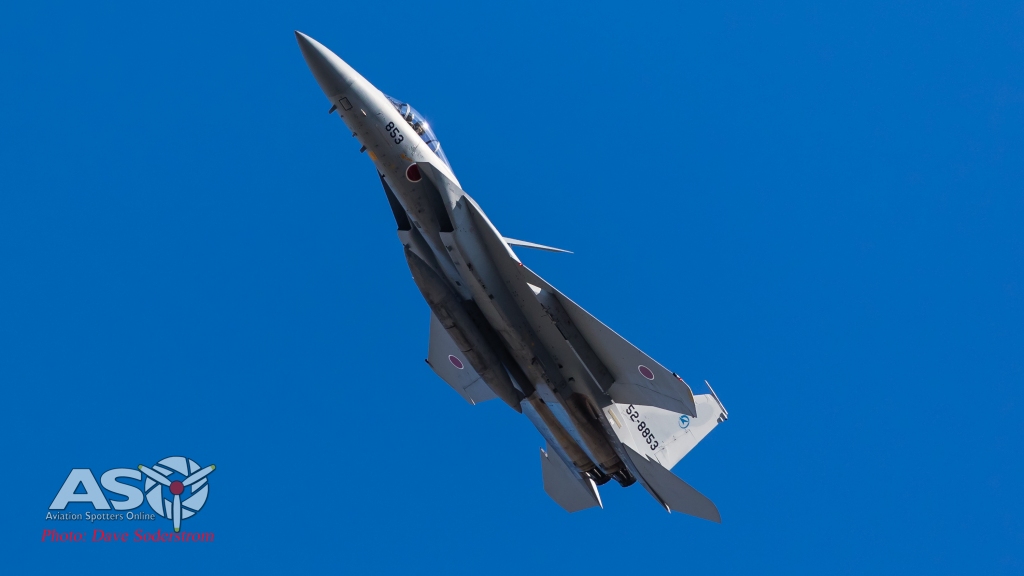
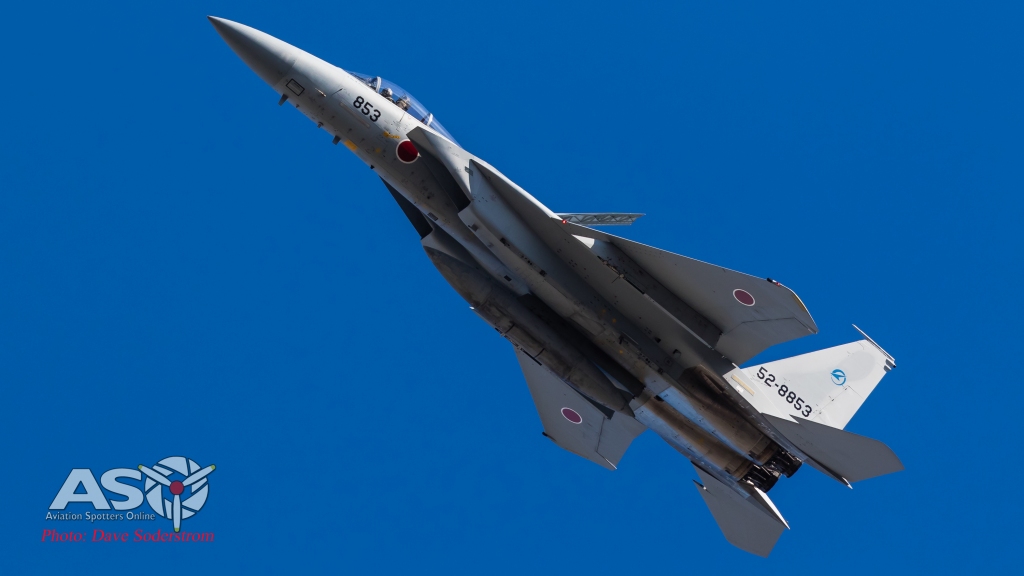

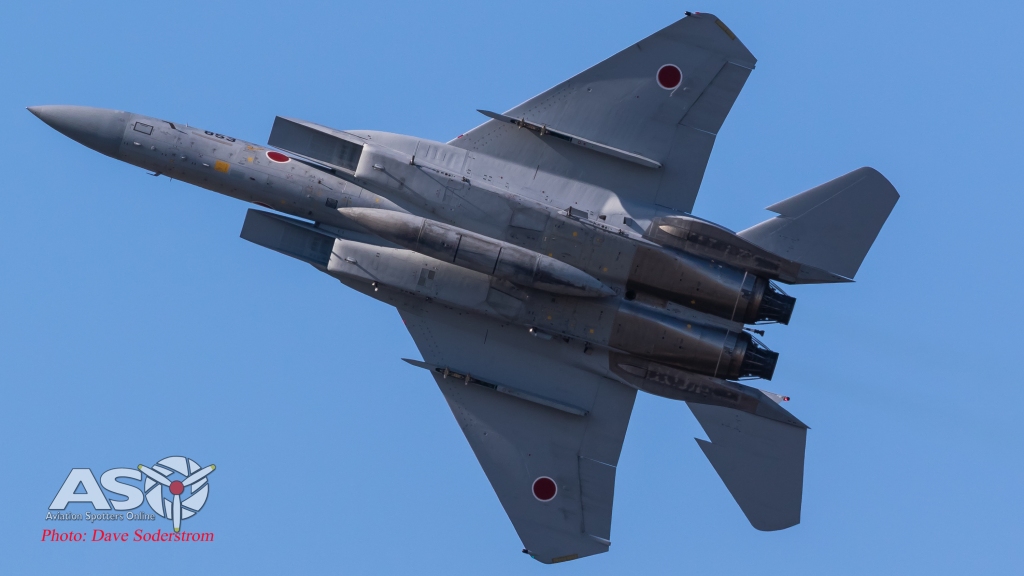


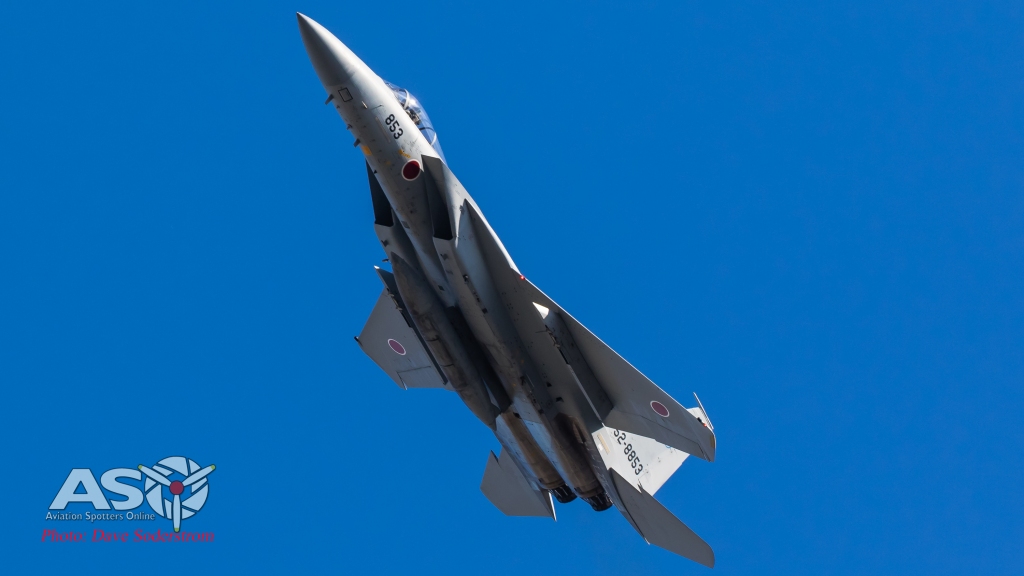
McDonnell Douglas F-4EJ Phantom II
Now in its twilight years of service, The McDonnell-Douglas F-4E Phantom II. Japan selected the F-4 Phantom II as its new fighter at the end of the 1960s. Japan became one of the few countries that license-produced this aircraft outside the USA. a total of 154 F-4EJ and RF-4Es. The F-4EJs were built almost entirely by Mitsubishi Heavy Industries, the RF-4Es were bought directly from McDonnell-Douglas. The Phantom has served with a number of Units with retirement scheduled in 2021. The aircraft will be replaced with a mix of F-2s and F-35 Lighting II’s. Units to fly the aircraft includes:
- 8th Hikōtai
- 301st Hikōtai
- 302nd Hikōtai
- 303rd Hikōtai
- 304th Hikōtai
- 305th Hikōtai
- 306th Hikōtai
- 501st Hikōtai
During the show F-4EJ aircraft 47-8336 performed a great display was from the 23rd Flying Training Squadron which is part of the Air Development and Test Wing.

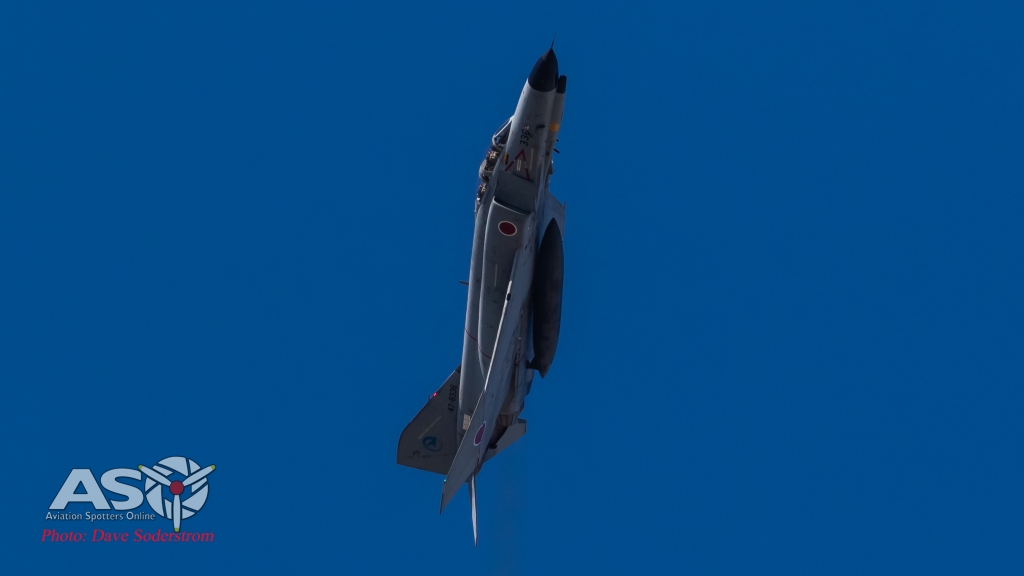

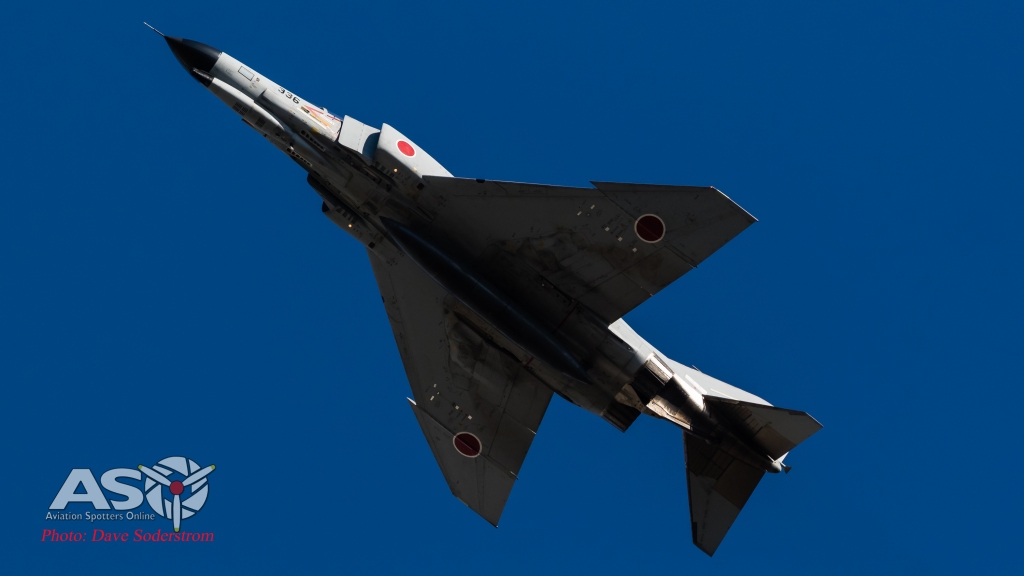

Gear down dirty pass.


‘because I was inverted’
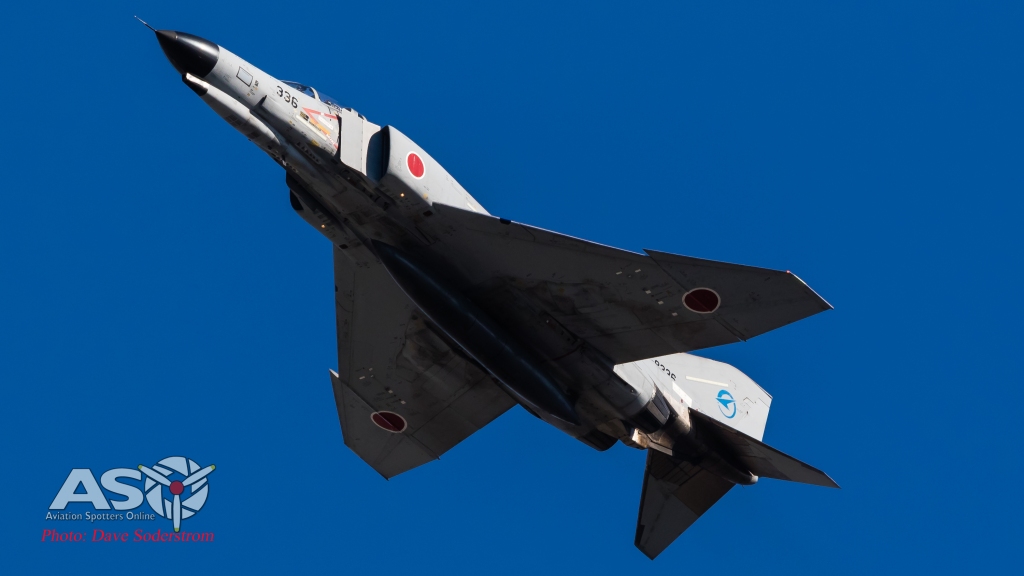
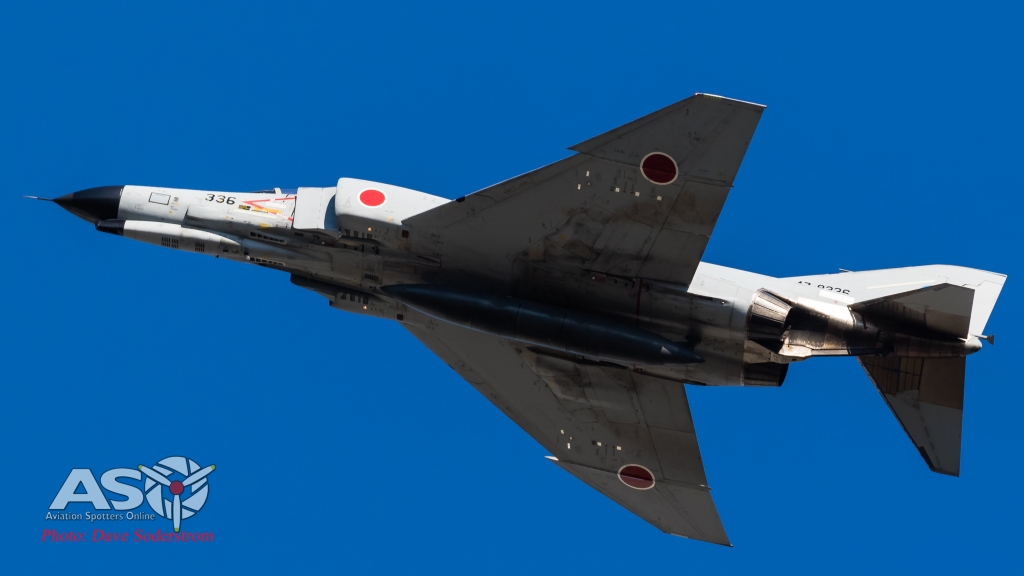
Powered by two General Electric J79-GE-17A after-burning turbojet engines, which produce some 11,905 lbf (52.96 kN) thrust each dry, 17,845 lbf (79.38 kN) with afterburner.
After the Phantom display which was loud and impressive anything else would almost seem lack lustre. However a nine ship formation of Kawasaki T-4s wasn’t half bad.


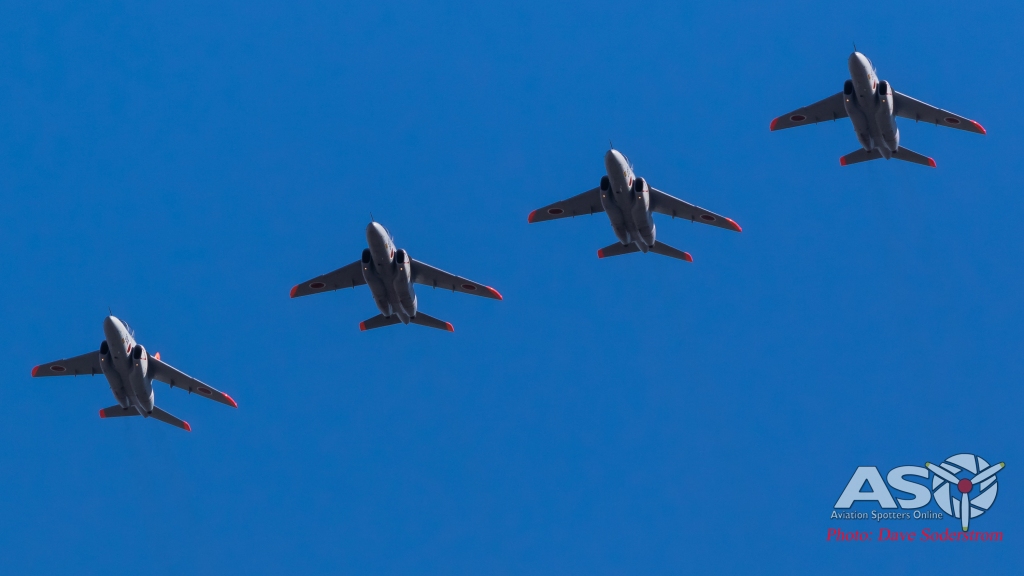
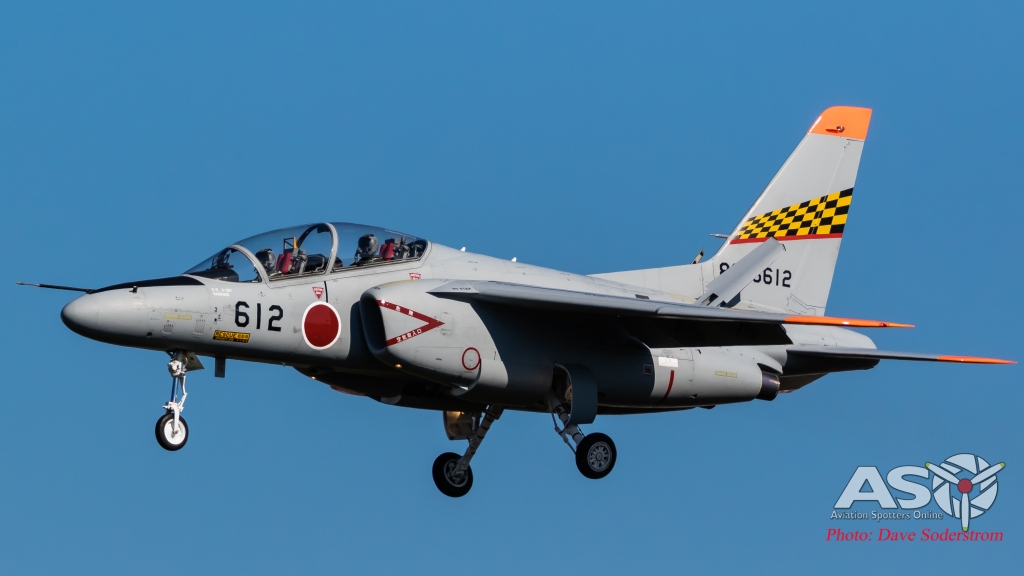



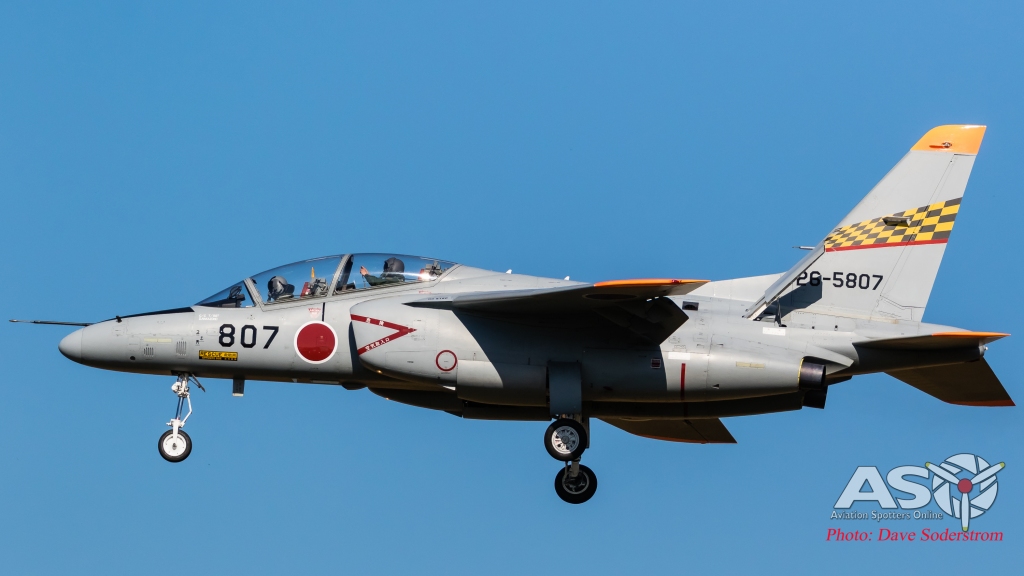

Base Displays
After the main displays there was a break for lunch, during this period I headed into the main base to record the day’s activities.
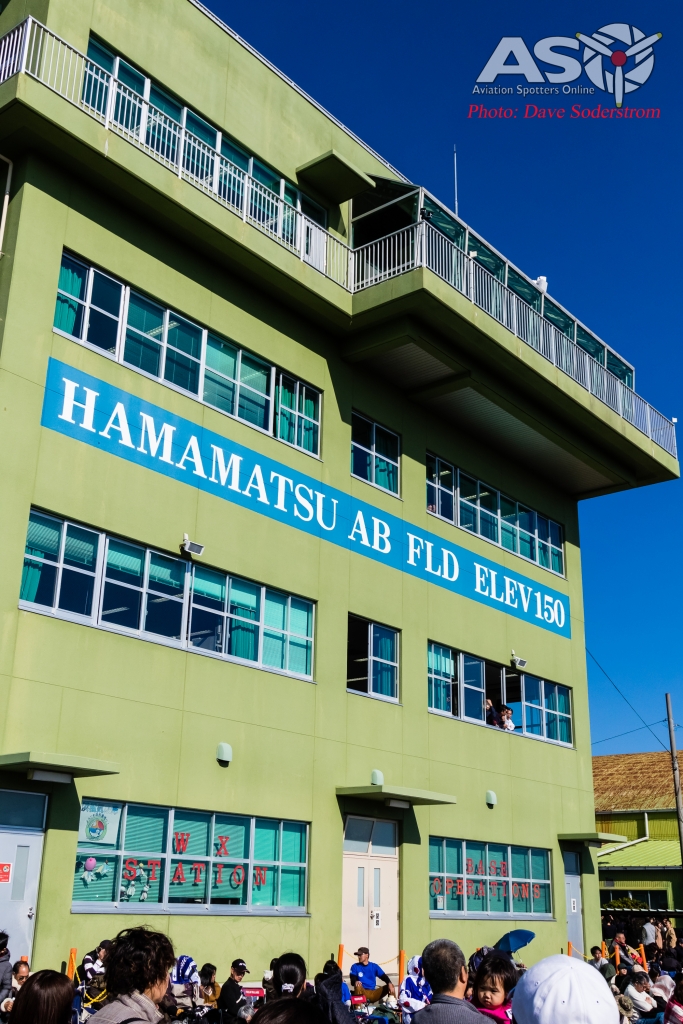
The base was full of interesting displays, this included several T-4s in various degrees of servicing.
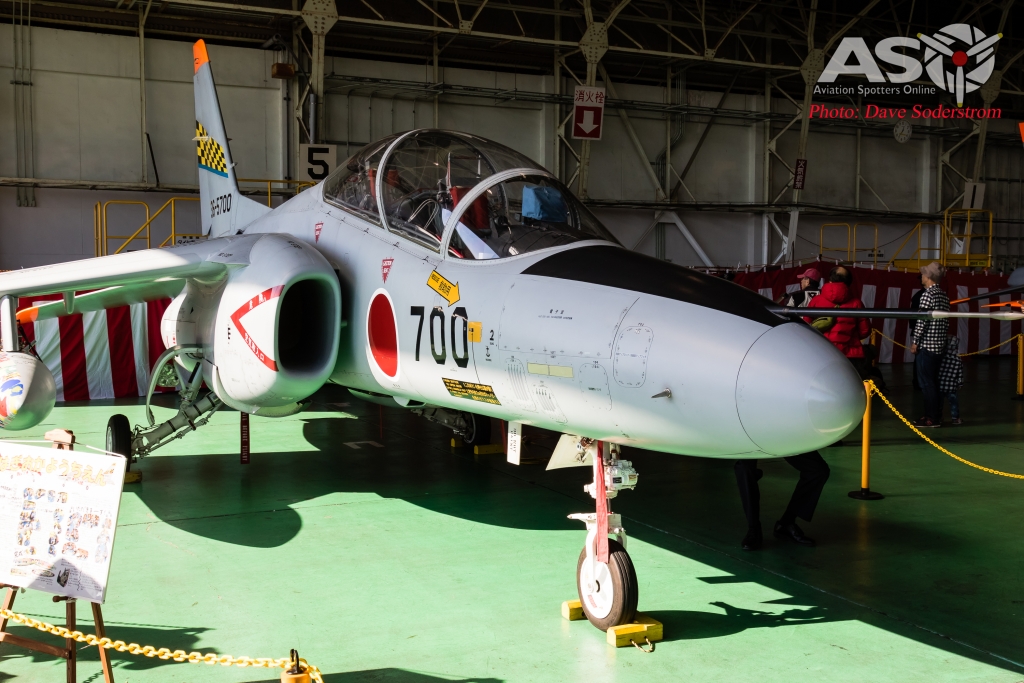
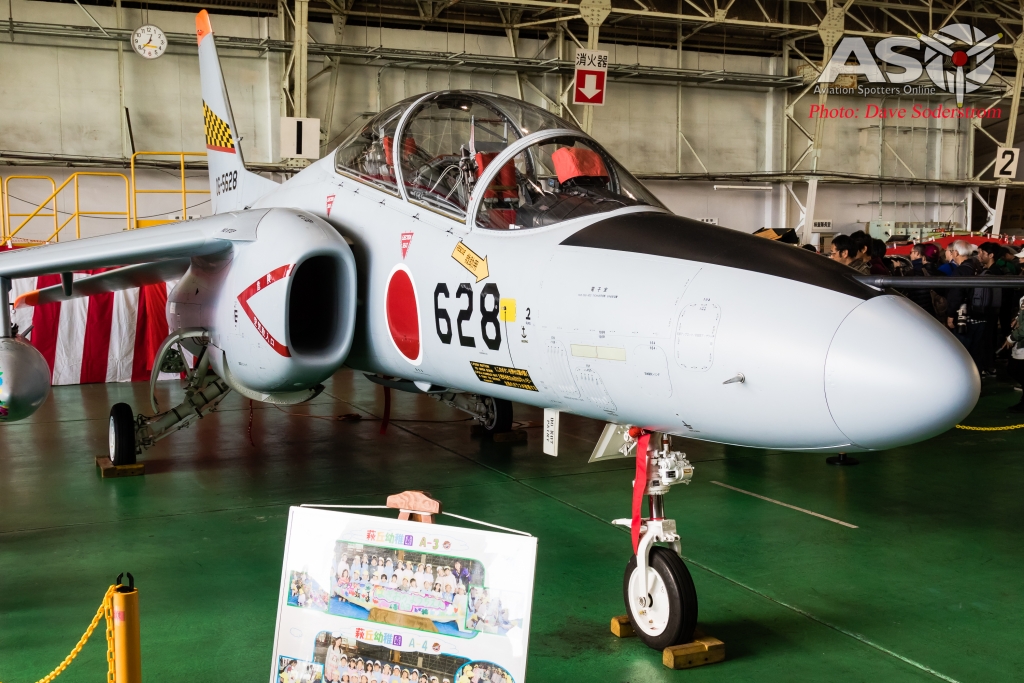
One of the local schools had their kids come to the base and paint up some of the fuel tanks for the T-4s.

This particular T-4 preformed landing gear retraction test throughout the day.
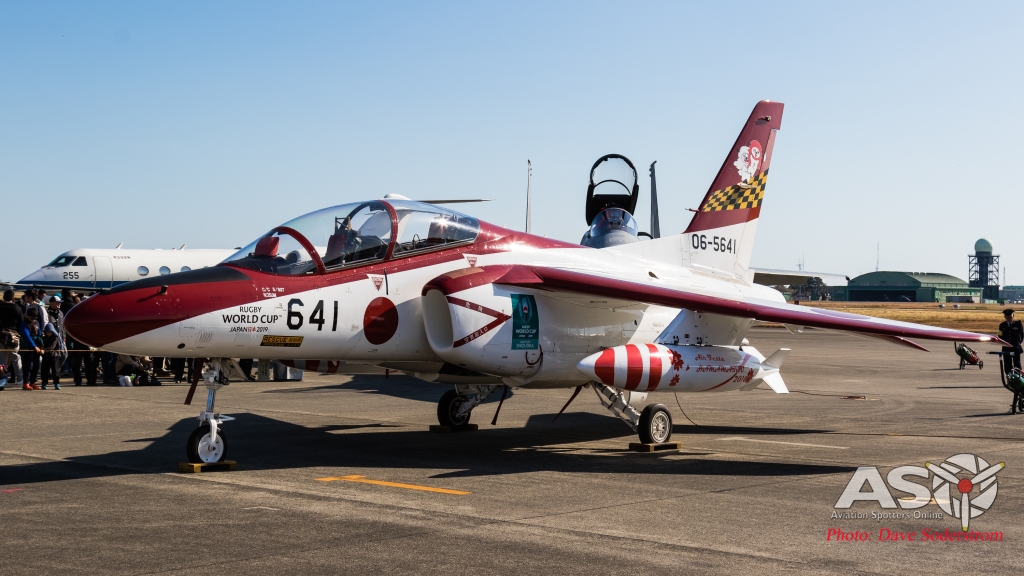
T-4 06-5641 is seen sporting the Rugby World Cup decals which is being hosted in Japan in 2019.
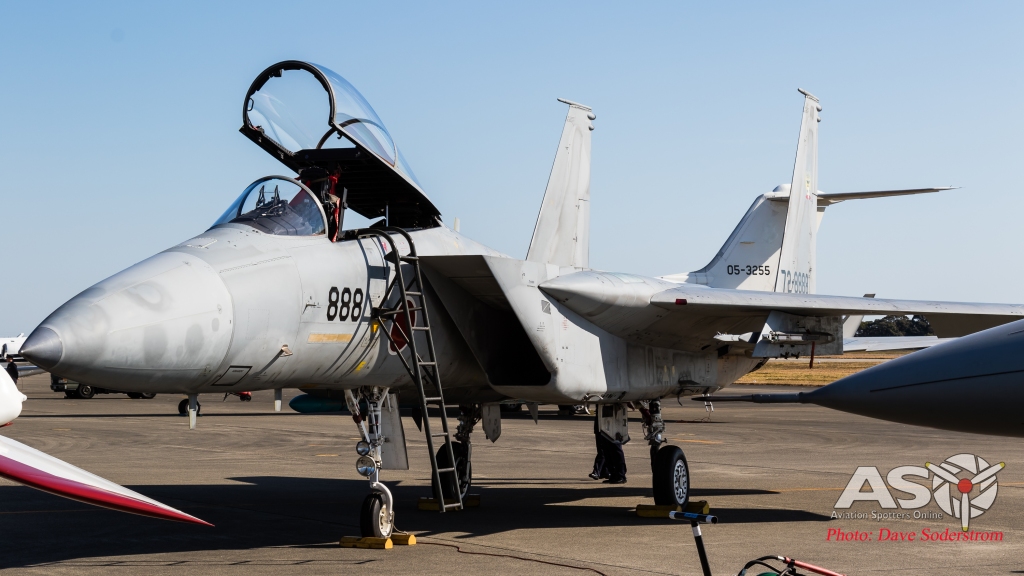
F-15J, 72-8888 was the static display aircraft for the show.
Mitsubishi F-2
The Mitsubishi F-2 is a multirole fighter derived from the General Dynamics F-16 Fighting Falcon, and manufactured by Mitsubishi Heavy Industries and Lockheed Martin, with a 60/40 split in manufacturing between Japan and the United States. Production started in 1996 and the first aircraft entered service in 2000. The first 76 aircraft entered service in 2008, with a total of 94 airframes produced. On display at the show was an F-2 from the 1st Training School. The primary role of the 1st TS is to provide the full gamut of technical training on the maintenance of the aircraft in service with the JASDF and the weapons with which the combat aircraft types are armed.

This F-2 belonging to the 航空自衛隊第1術科学校 (1st Technical School kōkūjieitai-dai-ichi-jutsukagakkō) is a training unit belonging to Air Training Command based at Hamamatsu Air Base. The school flies the F-2, F-4, F-15, T-4 and T-7.
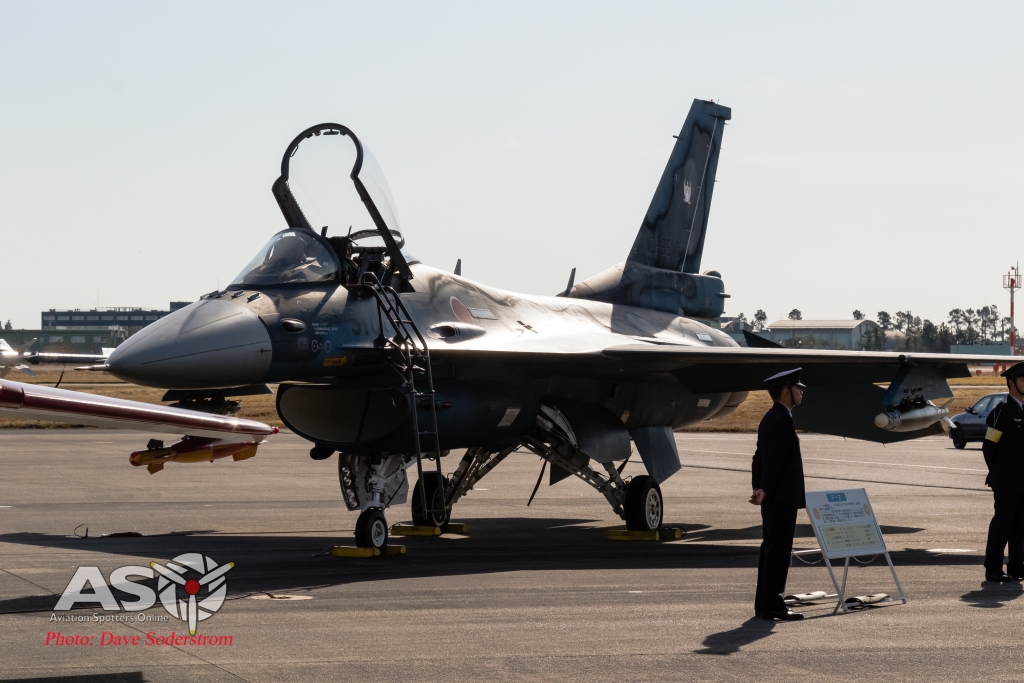
The aircraft wasn’t in any easy position to photograph it sadly.
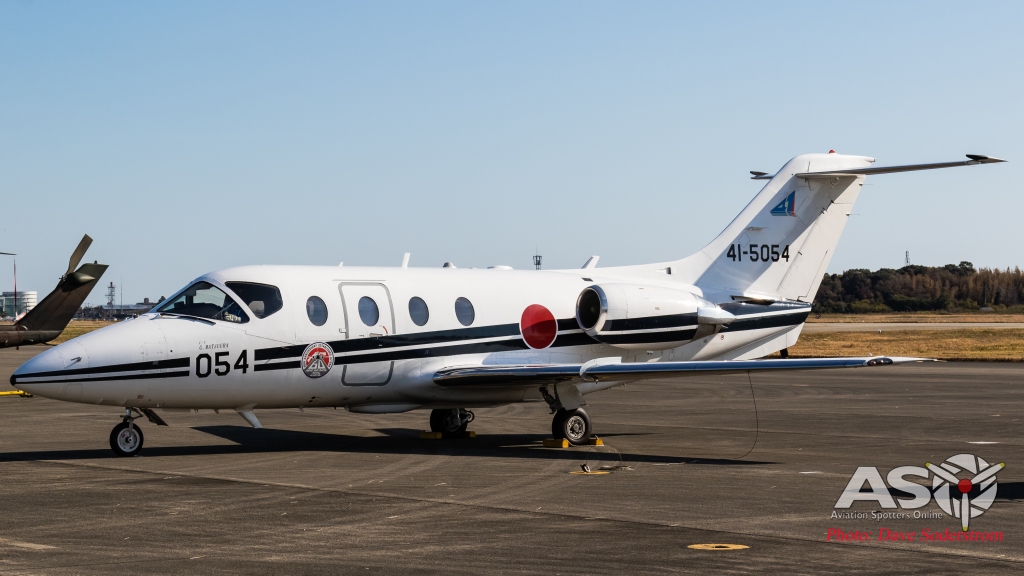
Beechcraft T-400 Jayhawk 41-5054 was on the static display line after its air display.
Bell AH-J Cobra
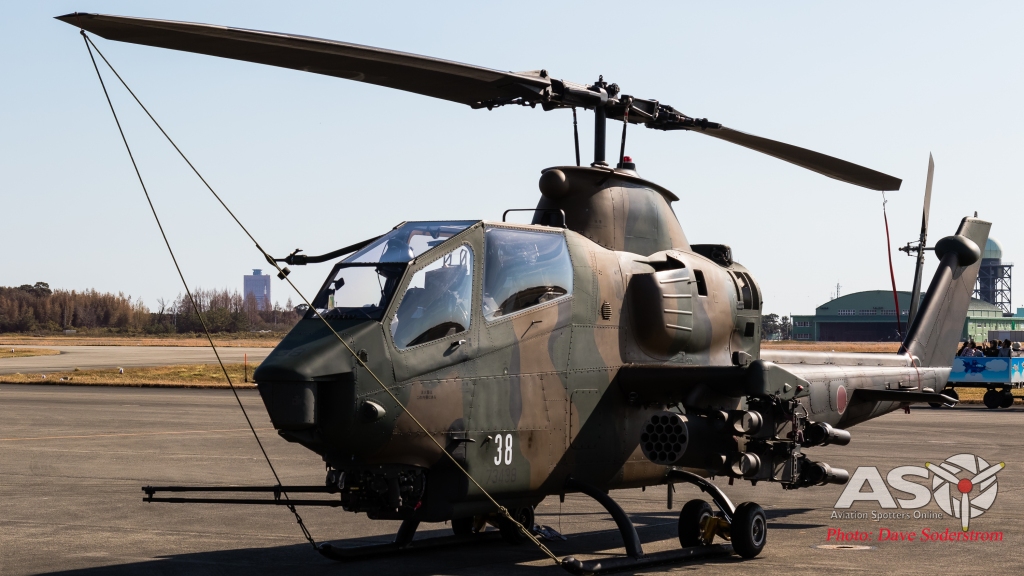
Bell AH-1J Cobra Japan manufactured 89 AH-1S Cobras under license by Fuji Heavy Industries from 1984 to 2000. The type is used by the Japan Ground Self-Defense Force, and are Step 3 models, which are roughly the equivalent to the U.S. Army’s AH-1Fs. The engine is the T53-K-703 turboshaft, which Kawasaki Heavy Industries produced under license.

Northrop Grumman E-2 Hawkeye
The JASDF purchased thirteen E-2C aircraft to improve its early warning capabilities. The E-2C was put into service with the Airborne Early Warning Group (AEWG) at Misawa Air Base in January 1987. 89iuIn June 2015, the Japanese government requested to buy four E-2Ds through a Foreign Military Sale. A follow up order placed in September 2018, by the Defence Security Cooperation Agency notified Congress of the possible sale of up to 9 E-2Ds to Japan.



The eight-bladed propeller system which is named NP2000 was developed by the Hamilton-Sundstrand company to replace the old four-bladed design. Improvements included reduced vibrations and better maintainability as a result of the ability to remove prop blades individually instead of having to remove the entire prop and hub assembly. The propeller blades are of carbon fiber construction with steel leading edge inserts and de-icing boots at the root of the blade.
Kawasaki C-2
The Kawasaki C-2 is a long range twin-engine transport aircraft. In comparison with the older C-1 that it replaces, the C-2 can carry payloads up to four times heavier. Powered by a pair of General Electric CF6-80C2K turbofan engines. Some 40 examples are on order.
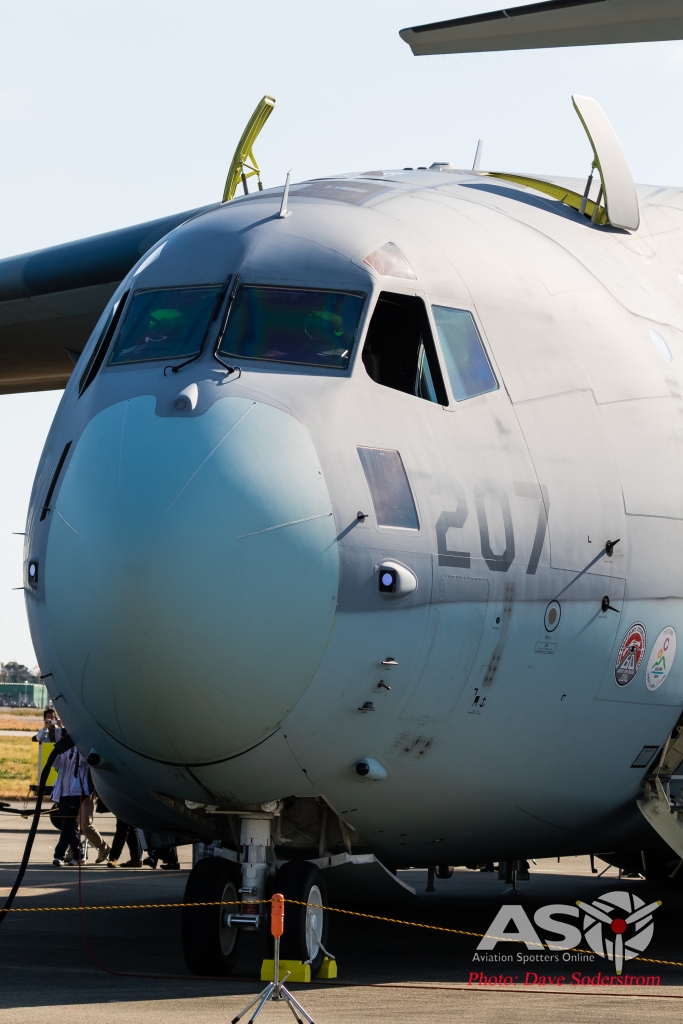
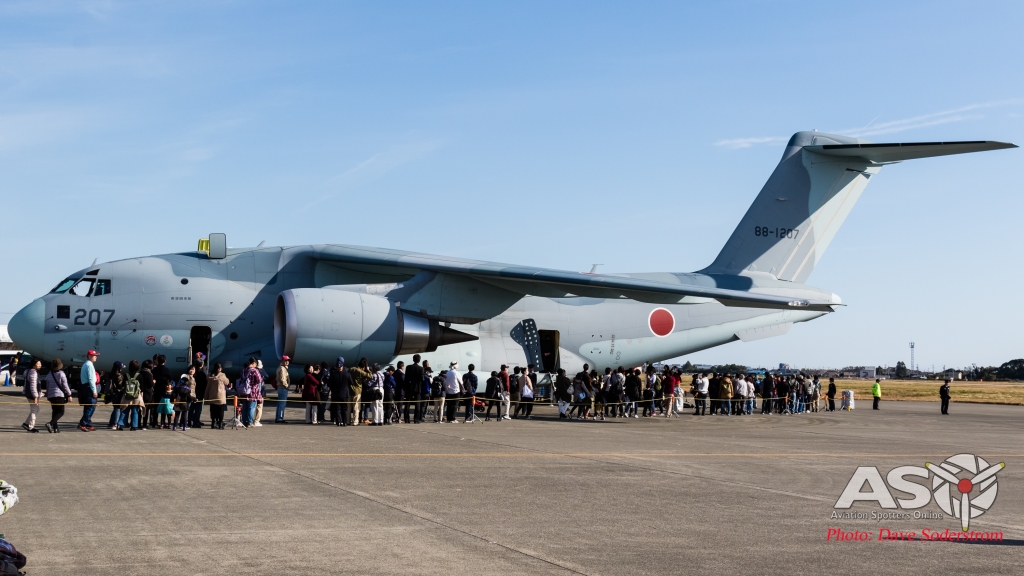
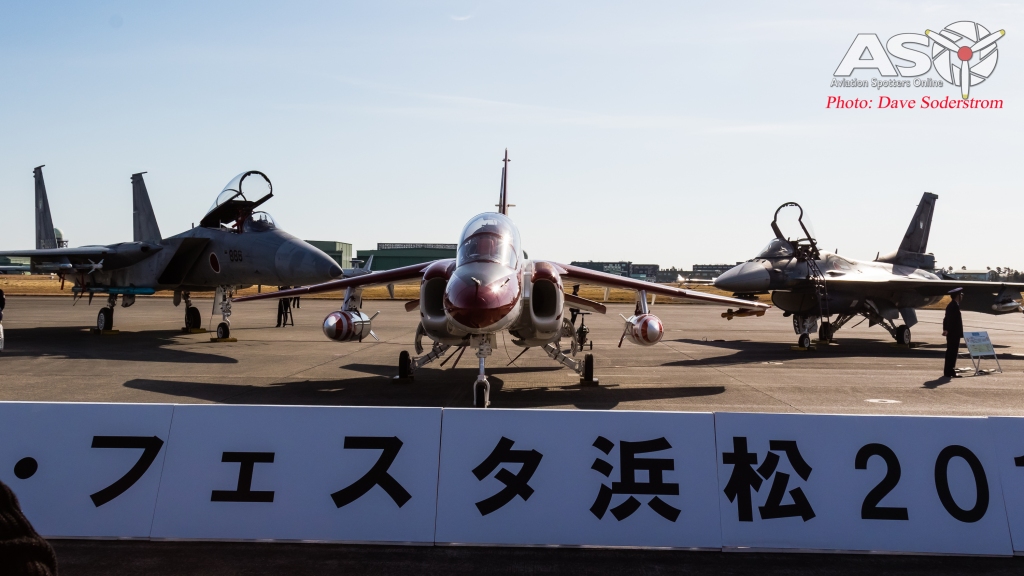
The Finale- The Blue Impulse Display Team
As the airshow drew to a close the hype for the next performance was very noticeable. People standing to see the crews prepare to depart, waving as they taxied out and people rushing to gain a better view as the Blue Impulse display team set about wowing the attendees. The teams flew several different displays involving up to six aircraft, solo displays and four ship formations. The team currently operated by number 11 Squadron, part of the 4th Air Wing is based at Matsushima Air Base.



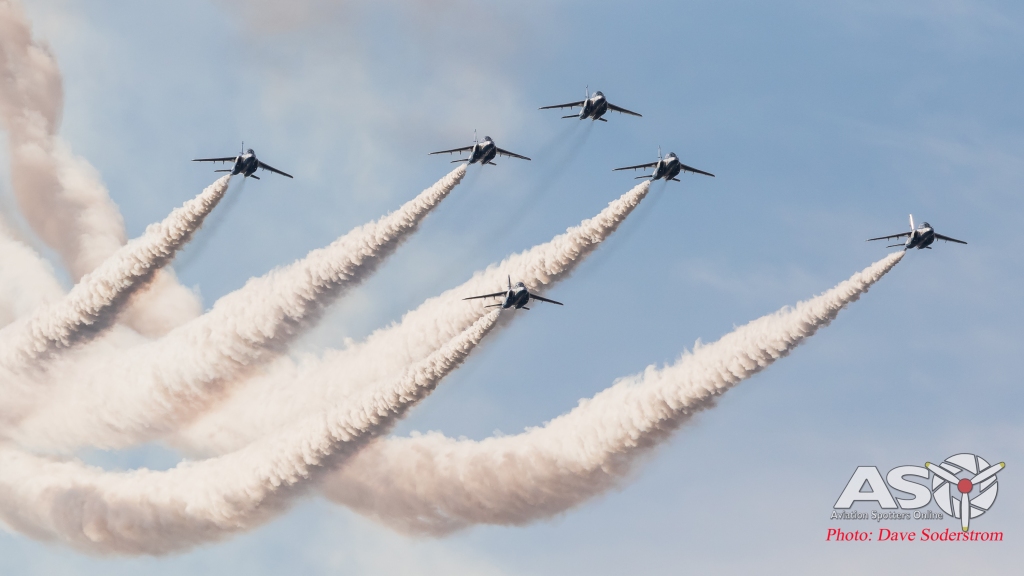

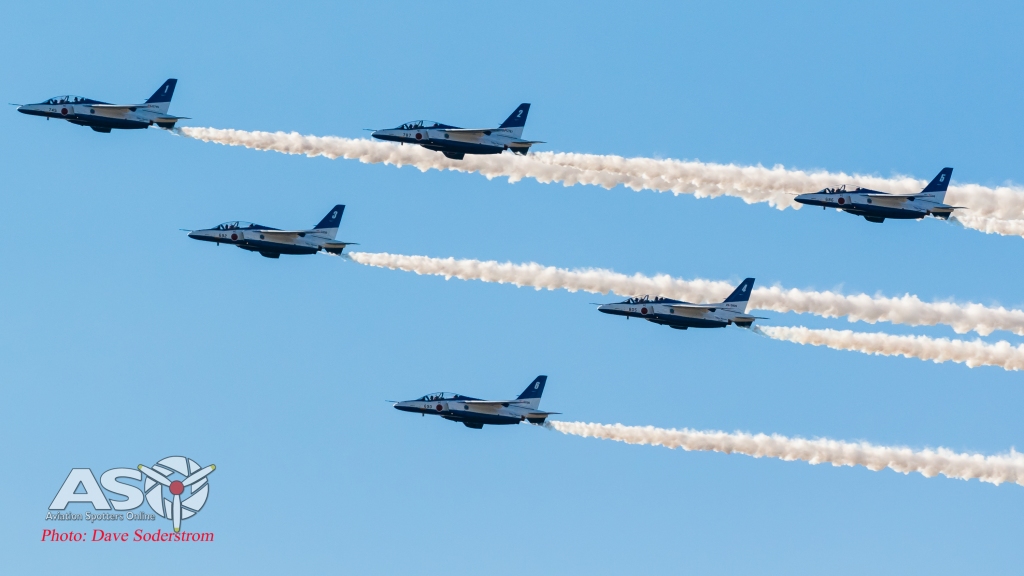


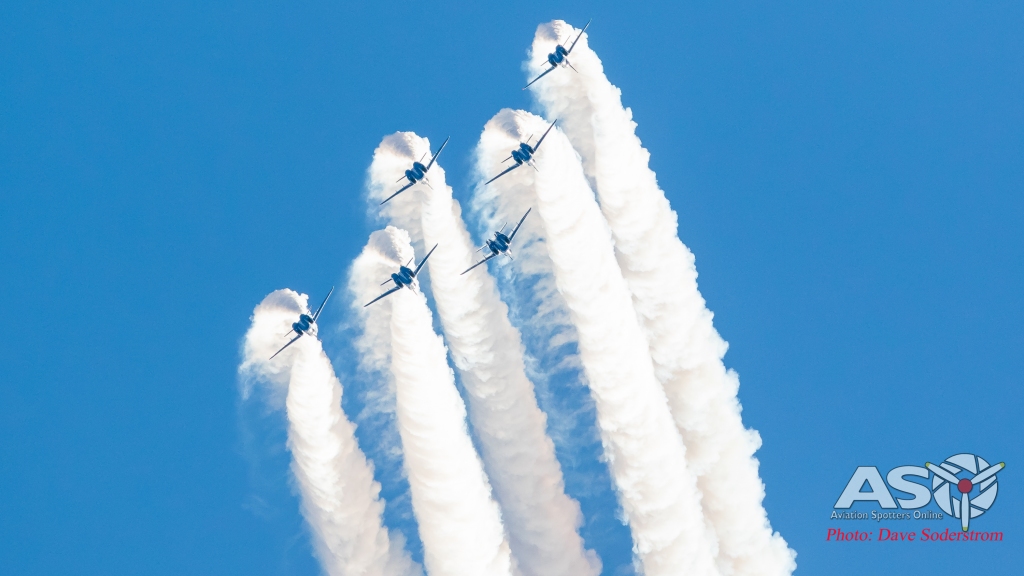


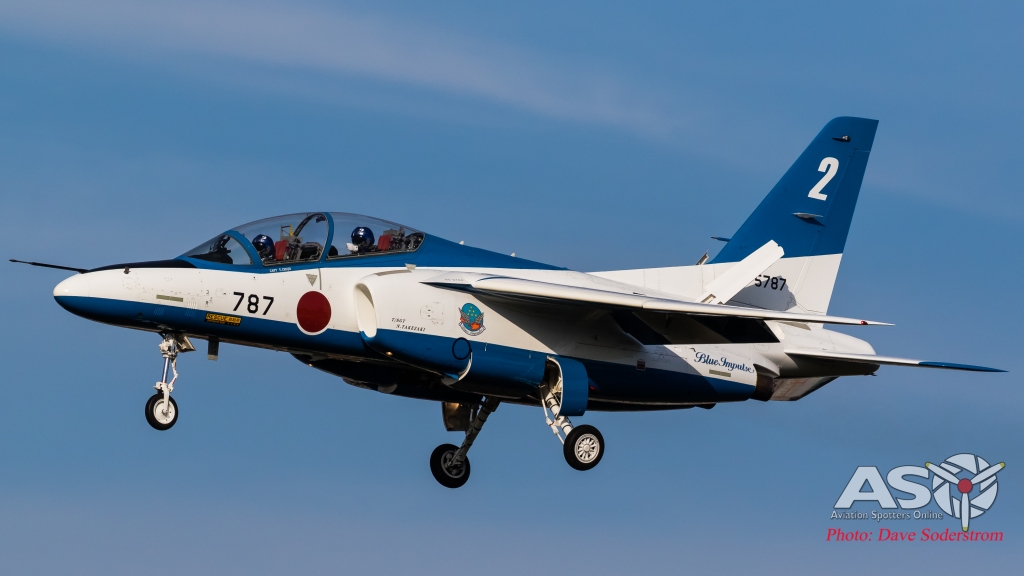




Another great adventure to another Japanese base, I hope you all enjoyed this over view of the event. In out next instalment it will cover the JASDF Museum at Hamamatsu. Lots of interesting aircraft and helicopters.
Dave.
See Part One of Dave’s series of Japanese Air Base visits HERE
Or if you want to be notified when the next ASO article is published you can register ….


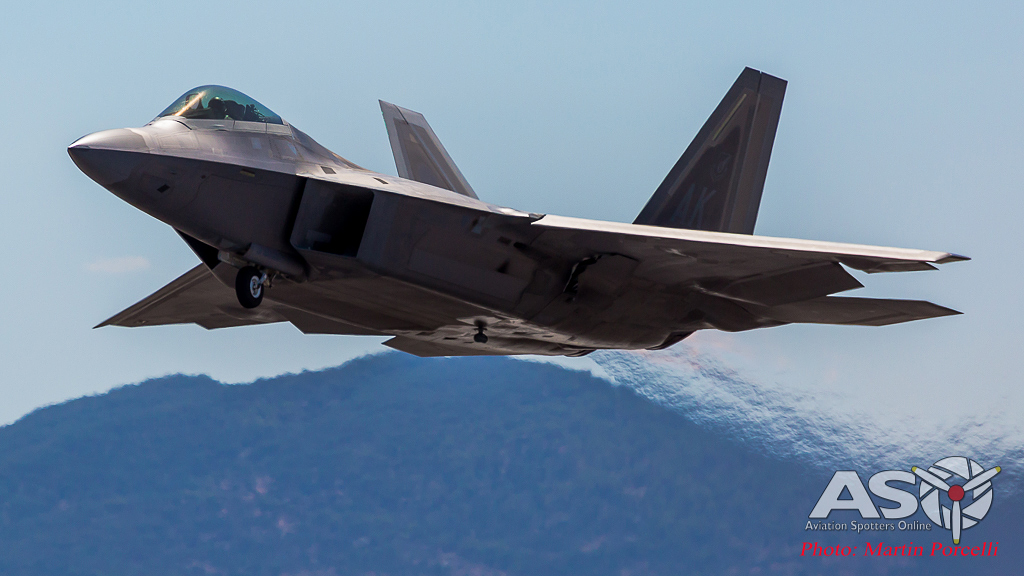






hard to be the f4 for awesomeness really